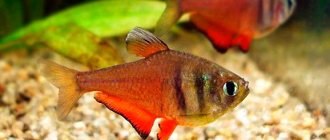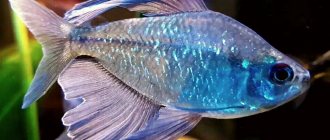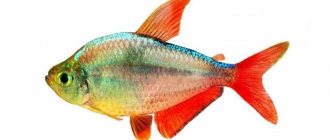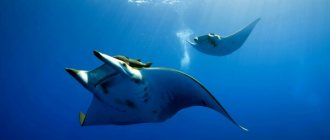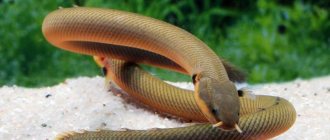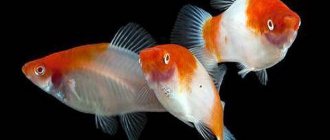Device for combing cats and dogs Discounted item (No. 66)
665 ₽ More details
Furminator for dogs FURMINATOR S for small short-haired breeds
1739 ₽ More details
Dog kennels
The depths of the ocean hide a large number of unusual creatures. They have a frightening appearance and unusual behavior. A fish with a flashlight on its head is called a monkfish. She has a very repulsive appearance, which does not prevent her from eating meat of this species. In European and Asian countries, this fish is considered a delicacy. She received such recognition for her high taste qualities.
Monkfish has a very repulsive appearance, but is still used in cooking
general characteristics
There is another name for a fish with a flashlight on its head - it is an anglerfish . This is a predator that belongs to the order of anglerfish and the class of bony fish. Lives at the bottom of the sea. It reaches two meters in length. Average weight - 20 kg. Large individuals weighing 57 kg are also known.
The body is flattened, compressed in the abdominal direction. The mouth is several times larger than the head.
The anglerfish's jaw is inactive, the mouth is several times larger than the head
A distinctive feature of the monkfish is its slightly protruding lower jaw. She is inactive. The mouth is decorated with sharp teeth that are slightly curved inward. The jaws have flexible and thin bones that allow the anglerfish to swallow large fish. There are small eyes at the top of the head.
A separate process grows from the dorsal fin. It is shifted to the upper jaw and represents a fishing rod. There is a leathery formation on it - it serves as bait and is a bag of mucus in which luminous bacteria live. The angler can turn off the light for a while so as not to attract the attention of large predators.
The habitat of deep sea flashlight fish is varied. It can be found in countries such as:
- Canada;
- USA;
- Japan;
- Korea.
Some representatives of the species are found in the waters of the Black and Yellow Seas. It can live at different depths.
Angler fish can live at different depths
Appearance and gender differences
Tetra - Lantern has an elongated body of a grayish-silver color, the abdomen is of lighter colors, and the sides are decorated with a dark stripe, which imperceptibly turns into a small black spot on the caudal fin. A luminous spot of orange-golden color adorns the tip of the caudal peduncle. And one more light spot is characteristic of the areas above the eyes and behind the gill cover. Although this particular spot cannot always be seen with the naked eye. Thanks to the presence of these luminous “eyes”, the flashlights got their name. But the fins on the body of these fish are considered colorless, and on the anal fin there is a so-called spine, which, like a hook, can catch on a net. The length of the fish reaches 5-6 centimeters. The female is much larger than the males - her abdomen is larger. In addition, the female has a swim bladder, which is clearly visible in the light.
Main representatives of the species
Ichthyologists distinguish several varieties of anglerfish. In addition to the American monkfish, the European anglerfish is also distinguished. His body is flattened from back to belly. It grows up to two meters, its weight exceeds 20 kg. He has a huge crescent-shaped mouth. Powerful pectoral fins allow it to bury itself in the sand. The most common individuals are brown in color. Lives only in the Atlantic Ocean.
Black-bellied anglerfish are similar to their closest relatives. They have a wide head and small body size (individual length 50 cm). A characteristic feature is the wide abdominal part. Painted in gray or beige colors. There is no rod on the head.
The Burmese monkfish is distinguished by its flattened head and short tail. The length of the individual does not exceed one meter. The body is covered with leathery fringe. The lower part of the body is white, the upper part is dark.
The terrible appearance of anglerfish has given rise to a lot of superstitions. Many people believe that monkfish attack swimmers. During periods of hunger, fish rise to the top layer of water and can bite a person. At other times, the anglerfish lives on the bottom and does not collide with the drivers.
https://youtube.com/watch?v=yIP1yB6ZT40
Due to its high taste, monkfish meat has become popular, so environmentalists have proposed a ban on fishing to preserve the species. It has been illegal to harvest anglerfish in the UK since 2007.
Habitat
Widely distributed in the tropical part of the South American continent in the territory of the modern states of Guyana, Suriname, French Guiana, Peru and Brazil, they live in numerous rivers and their slow-flowing tributaries flowing among humid rain forests. It is almost impossible to find fish caught in the wild for sale. Due to its popularity and unpretentiousness, it is bred commercially in huge quantities, mainly in Eastern Europe.
Brief information:
- Aquarium volume - from 70 liters.
- Temperature - 24–28°C
- pH value – 5.5–6.5
- Water hardness – soft to medium hard (5–20 dGH)
- Substrate type - any sandy
- Lighting - dim
- Brackish water - no
- Water movement is weak
- The size of the fish is about 4.5 cm.
- Food - any food
- Temperament - peaceful
- Keep a flock of at least 6–10 individuals
Nutritional Features
A fish with a flashlight on its head is a predator. Therefore, its main food is other marine inhabitants. The monkfish rises to the upper layer of water, where herring and mackerel become its prey. Ichthyologists noted a case when an anglerfish attacked birds that landed on the water.
The anglerfish is a predatory fish that feeds on other types of fish.
Basic diet:
- cod or sand lance;
- stingrays;
- sharks;
- acne;
- crustaceans;
- shellfish
A fish with a lantern on its head is an ideal hunter. She can sit in ambush for hours. Natural coloring allows you to blend in with the soil or plants. The monkfish puts out its fishing rod and waits for its prey. As soon as the fish grab the bait, they immediately swallow it. A special feature of the anglerfish is the ability to hold its breath for several minutes. https://youtube.com/watch?v=FWSq6DDGcrE
Feeding
Since the lantern fish has been bred in the artificial environment of aquariums for many generations, it is perfectly adapted to any dry industrial food (flakes, granules, etc.).
As a recommendation, to maintain the tone of the fish, you should give a combination of a variety of foods including live or frozen foods, such as bloodworms, daphnia and brine shrimp.
Reproduction of anglerfish
Representatives of this species are distinguished by special reproduction. Females and males are very different from each other and ichthyologists have long considered them to be different fish. When the male reaches the age of sexual maturity, he goes in search of a life partner. A large olfactory organ and huge eyes help him in this.
Ichthyologists do not know how long the search takes. Once a female is discovered, the male latches onto her with his jaws. His tongue and lips completely grow into the bride's body. She takes him into complete dependence and supplies him with nutrients through ingrown vessels. The male's intestines, jaws and eyes atrophy. The gills and heart work in his body - they supply the body with oxygen.
Female and male anglerfish have long been considered representatives of different species
During spawning, the female lays eggs, and the male inseminates her with milk. This happens in winter and spring. The caviar comes out in the form of a strip. Its length can reach 9 meters. Young fish switch to a bottom lifestyle when their body length is 6 cm. Before this, they live in the upper layer of water and feed on small crustaceans and fry. It is noteworthy that females can carry up to four males at a time .
Conditions of detention
Tetra flashlight
is one of the most popular representatives of tetras, characterized by a peaceful and hardy character. They get along well with other aquarium fish of the characin family, dwarf cichlids and catfish. They prefer to stay in the upper and middle layers of the aquarium. An aquarium with a capacity of at least 50 liters is ideal for keeping a flashlight. The aquarium should be planted with thickets of aquarium plants, but at the same time leave free space for swimming. Flashlights are schooling fish, so it is better to keep them in a school of at least 6 individuals. Optimal water parameters for keeping the lantern tetra: temperature 20–25°C; hardness no more than 18°, pH 6.5-7. Aeration, filtration and weekly water changes up to a quarter of the aquarium volume are desirable. Both live and dry food can be used as food; it is recommended to feed the fish with plant food.
Lantern Tetra - Hemigrammus ocellifer
Hemigrammus ocellifer is an elegant schooling aquarium fish characterized by an unassuming and peaceful disposition. Ideal for keeping in densely planted aquariums, where the beauty of this species is fully revealed. its second and most common name - Tetra Lantern - for its bright shiny eyes and because of the golden spot at the tail, which seems to emit light.
The Tetra Lantern comes from the river basins of the South American continent (Amazon River, Orinoco River, Guiana River). In its natural environment, this species is found in slow-moving and shallow tributaries that flow among moist rain forests.
Appearance and gender differences
The Lantern Tetra has an elongated silver-gray body with translucent fins. This species has large expressive eyes, the upper third of the eye is orange-red. A barely visible dark stripe stretching along the lateral line is bordered by two large dark spots. The first spot is located immediately behind the gill cover, the second at the base of the tail. A luminous spot of golden-orange color adorns the tip of the caudal peduncle. Another light spot is characteristic of the areas behind the eyes and behind the gill cover. The jaws are equipped with a large number of small teeth.
Sexual dimorphism is weakly expressed. Females are often slightly larger than males with a more rounded abdomen. A characteristic feature of all males of the Hemigrammus genus is the anal fin. Males have a “hook” on the anal fin, as well as a transverse milky-colored streak that crosses the first 3–4 rays of the anal fin.
The maximum size that Tetra Flashlight can reach in a home aquarium is no more than 4.5 cm. Life expectancy under good maintenance conditions is ~ 5 years.
Conditions of detention
A natural-looking structure is recommended for keeping this species, which may consist of a soft sandy substrate, natural driftwood and stones placed in such a way as to provide plenty of shaded areas. It is also advisable to plant the aquarium densely with plants, but at the same time provide sufficient space for swimming. The volume of the aquarium is from 40 to 50 liters for a small school of fish. Tetra Lantern prefers to stay in the upper and middle layers of water. If the school is small, the fish become inactive.
Water parameters: 22 – 26°C, pH 6.0 – 7.5, dH 5 – 18°.
In general, this is an unpretentious fish, resistant to stressful conditions. However, it is worth creating comfortable conditions for your pets and trying to minimize shock situations that can lead to the death of fish (sudden temperature changes, sudden changes in the level of nitrogen compounds, etc.). Aquarium maintenance comes down to weekly replacement of part of the water (~ 25%) with fresh water and regular cleaning of the soil and glass from organic waste and plaque.
Aquarium mates
Tetra Lantern is a peaceful schooling fish. It is recommended to keep it in a group consisting of at least 6 – 8 individuals, since it is when kept in a school that fish exhibit more interesting behavior and the brightest colors. In a community aquarium, the Tetra Lantern can peacefully coexist with any species of similar size and temperament (preferably kept with other species of characin fish).
Obviously, due to the small size of Tetra Lantern, sharing with large and aggressive fish is not advisable.
Feeding
The basis of the diet can be either small frozen live food (brine shrimp, daphnia, coretra, bloodworms, etc.) or dry food of suitable sizes. It is advisable to include herbal supplements in the diet (dry food with spirulina and other algae). When combining different foods, the fish feel better and their color intensifies.
Breeding
Breeding of the Lantern Tetra is typical, as for most representatives of the characin family.
For spawning, a separate 20-liter aquarium is required, in which small-leaved plants are placed. The light is overhead, diffused. The water column level is 15 cm - 20 cm, so that the fish can swim freely and feel comfortable. Water parameters stimulating the onset of spawning: t 27 – 28°, pH 6.5 – 6.8, dH 4 – 6°.
For spawning, it is better to plant one female and two males; the female’s productivity is from 150 to 450 eggs. The caviar is small, transparent, and sticky in the first hours. Spawning usually occurs on the 3rd or 4th day in the morning. The eggs are scattered onto the plants and the bottom of the spawning tank. After spawning, the parents are immediately removed (although the parents do not eat the eggs), and the spawning tank with the eggs is shaded. During the first day, very small transparent larvae hatch from the eggs, which after 4 days turn into fry. Starter food for juveniles is ciliates, rotifers and Artemia nauplii.
The Tetra Flashlight reaches sexual maturity at the age of 6 – 8 months.
Compatibility
One of the best candidates for a community aquarium, it goes well with other peaceful fish of a similar size, for example, viviparous species, zebrafish, rasboras, tetras, corydoras catfish, etc. Obviously, due to the small size of the lantern fish, sharing with large fish can be dangerous for her.
Maintenance and care, arrangement of the aquarium
An extremely unpretentious fish that can feel great even in spartan conditions. However, it is still worth creating comfortable conditions for your pets. Namely, prepare a tank with a volume of 70 liters or more, the design of which uses a sandy river substrate, a certain amount of driftwood (natural or decorative) and a group of rooting and floating plants. Aquarium equipment is configured in such a way that the lighting fixtures provide dim light, and working filters do not cause strong currents. Water conditions are characterized by a slightly acidic pH value with low to medium hardness, and the temperature range varies between 24–28°C. Maintenance comes down to weekly replacement of part of the water (10–15% of the volume) with fresh water and regular cleaning of the soil from organic waste and glass from plaque.
Monkfish in cooking
Monkfish is suitable both for frying in pieces and for frying in layers on the grill, or cut into cubes and placed on skewers on the grill. Monkfish is boiled and stewed. The fish is especially popular in France, where the meat of its tail is prepared in many ways, for example with blackcurrant jam or sweet potato, and the head of the devil is used for rich, fatty, multi-spiced soup.
Monkfish meat is highly prized in Japan. Not only meat is eaten, but also liver, fins, skin and stomach.
The Chinese prefer to cook monkfish in a wok. The fillets are fried in oil with rice vinegar and soy sauce, sprinkled with ginger and chili. Then the wok is removed from the heat, the fish is covered with coriander and green onions, mixed, and served with rice. Everyone who has tried this dish finds it slightly smoky. It's all a play on spices and the characteristics of the wok. The fish turns out tender and very juicy thanks to quick frying.
In America, monkfish is cooked mainly on the grill. The fish is cut into pieces along with the skin and vertebral bone. Marinate with salt, olive oil and rosemary. The oil envelops the pieces of fish and prevents them from drying out. Monkfish is served with grilled vegetables, seasoned with lemon juice and olive oil.
In America, they prepare carrot puree with monkfish fillet meatballs. The carrots are boiled until soft, then simmered in heavy cream, chopped with the addition of coriander and salt. The monkfish fillet is crushed, mixed with salt and spices, formed into meatballs the size of a walnut, and steamed. The puree is served in deep plates, with a dozen meatballs placed in each and sprinkled with fresh herbs.
In Korea, the national dish He is made from monkfish and a sweet-spicy soup is cooked, to which they add a lot of vegetables and fried monkfish (fillet) in batter. Monkfish meat, seasoned with hot spices, is placed in rice dough (pancakes) and fried in a large amount of oil. Serve fish with soy sauce.
In gourmet restaurants in a number of countries you can find dishes where monkfish is presented in the following form. The fish is fried and served, doused with sweet and sour sauce, poached fish is served with lemon and lemon zest, as well as poached and served with parsley or spinach sauce with cheese. The fish is fried with chili pepper, smoked paprika and ginger, simmered in white wine, cream sauce, milk, baked with tomatoes, fried, strung on rosemary sprigs.
Monkfish is baked in the form of a roll. The fillet is laid out in a layer on film, the filling is placed on top, for example broccoli, and rolled up. The ends of the film are tied, the roll in this form is lowered into water and the fish is boiled for 10 minutes at a temperature not exceeding 86`C. With this method, the fillet remains soft and juicy, but holds its shape perfectly. The fish is served with creamy sauce and potato medallions fried in oil.
Monkfish are not often available for free sale, because... already mentioned above, the fish is under state protection and its catch is limited.
Unfrozen monkfish can be found in large hypermarkets at a very high price during a certain season or on the market from private sellers (this is in Europe and America). The rest of the time, if fish is sold, it is frozen, but its price is just as high - 20 euros per 1 kg.
